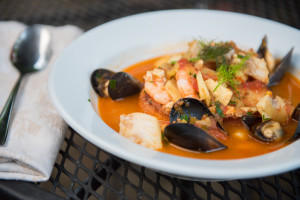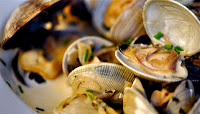 FISH STEWS—bouillabaisse, cioppino, chowder, bisque, fish head soup, and so on—are some of my favorite meals. Don’t let the authenticity police scare you into passing on such hearty and satisfying fare. These dishes are meant to be simple, to let the ingredients speak for themselves.
FISH STEWS—bouillabaisse, cioppino, chowder, bisque, fish head soup, and so on—are some of my favorite meals. Don’t let the authenticity police scare you into passing on such hearty and satisfying fare. These dishes are meant to be simple, to let the ingredients speak for themselves.
In Marseilles, partisans have been arguing over the ingredients and presentation of a proper bouillabaisse for as long as anyone can remember. Ignore the guy who tells you you’re doing it wrong.
The point of dishes like bouillabaisse or cioppino is to use whatever is fresh and on hand. In fact, I’d bet the origin of these dishes is probably less palatable than many would like to believe. The fish were probably those left unsold by the fishmonger. Perhaps they were bycatch on the boat, the sort of fishes that wouldn’t earn the fishermen any money. Into the stew pot they went, along with whatever else was lying around: onions, garlic, tomato, maybe a fennel bulb.
You can use store-bought fish stock or clam juice, but a homemade stock is best—a good excuse for buying that whole fish at the market and saving a bunch of money by filleting it yourself and using the scraps for stock.
Stock
1 (or more) white-fleshed fish carcass (enough to fill bottom of pot)
1/2 onion, chopped
1 carrot, chopped
1 or 2 celery ribs, chopped
1/2 cup white wine
1 bay leaf
2 sprigs thyme
1 handful parsley, chopped
salt and pepper
Cover fish carcass (in this case, halibut) with water. Simmer for 10 minutes. Add onion, carrot, celery, white wine, bay leaf, thyme, parsley. Simmer together another 20 minutes, until fish flesh is easily separated from the bones. Add more water if necessary. Season and strain. Yield: 1 quart.
Bouillabaisse
2 tbsp olive oil
1 small onion, diced
1 small fennel bulb, thinly sliced
3 cloves garlic, minced
1/2 cup white wine (or splash of Pernod)
2-3 cups tomatoes, cut up
1 pinch saffron
1 pinch hot red pepper flakes
2 tsp orange zest
1 quart fish stock (see above)
2 lbs or more assorted white fish fillets cut into pieces and shellfish
1 handful parsley, chopped
In a pot, heat olive oil over medium heat and sauté onion and fennel until softened. Deglaze with a splash of white wine. Add garlic, tomatoes, saffron, pepper flakes, and orange zest. Raise heat to medium-high and cook together a few minutes. Stir in 1 quart fish stock and bring to low boil. Add fish fillet pieces and cook several minutes (depending on thickness). Note: if using a mixture of firm fish and softer fish, add in stages to allow even cooking. Lastly, add shellfish and cover. When the shellfish are cooked, stir in parsley and remove from heat. Ladle immediately over crusty bread (optional: toast bread and rub with cut garlic). Serves 4.






.jpg&container=blogger&gadget=a&rewriteMime=image%2F*)





















